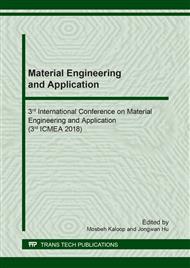p.82
p.87
p.92
p.98
p.104
p.110
p.115
p.120
p.126
Solid Biofuel Production from Meranti (Shorea Sp.) Sawdust Using Hydrothermal Treatment
Abstract:
In the context of industrialization, wood industry plays an important role as one of thepillar components in building Indonesia industry where 76.36% is supported by Meranti (Shorea Sp.).However, the increase of wood processing industries produces waste biomass in the form of largeamount sawdust. Hydrothermal treatment is an environmentally clean technology of convertingbiomass into coal-like solid called hydrochar using subcritical water. The purpose of this research isto determine the effect of temperature and water to biomass (b/w) ratio in the formation of hydrocharfrom Meranti sawdust. This research was carried out using a 250 mL hydrothermal reactor where amixture of Meranti sawdust and water heated at temperature variation of 240 and 300oC; b/w ratio1:20, 2:20, 3:20; initial pressure of 1.0 Mpa and holding time for 30 minutes. Hydrochar were thencharacterized in terms of yield, caloric value, proximate and ultimate analysis. Based on experimentalresult, 39-78% raw materials were converted into hydrochar where the highest yield was found ontemperature operation of 240oC and b/w ratio 2:20.
Info:
Periodical:
Pages:
104-109
Citation:
Online since:
November 2018
Keywords:
Price:
Сopyright:
© 2018 Trans Tech Publications Ltd. All Rights Reserved
Share:
Citation:


